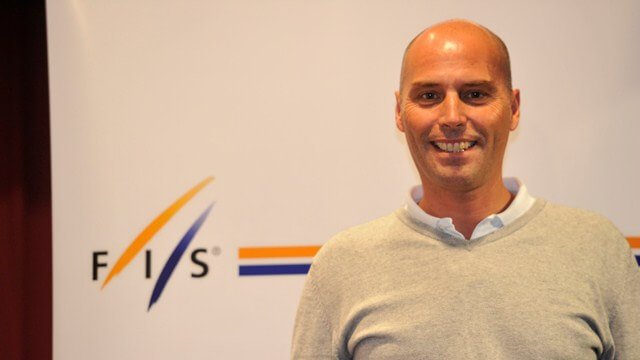Each year at the FIS Congress in June, the FIS officials and their stakeholders thoroughly discuss the FIS ski racing rule changes and make advised decisions that will best present alpine skiing both at the event and to the global audience and television.
Here is a summary of the major changes to the international ski racing rules that apply to alpine ski racing:
Speed Event Start Order
To further spread out the best skiers in the hopes of retaining television viewers beyond the top seed the Austrian proposal was accepted by the alpine executive board for start order in speed races. This means for the 2016-17 season onward, the starting order for men’s and women’s speed races (downhill and super-G) will be determined as follows:
- Athletes 1-10 on the World Cup Start List (WCSL) will select between bibs 1-19 (odd numbers)
- Athletes 11-20 on WCSL will be drawn between bibs 2-20 (even numbers)
- Athletes 21-30 on WCSL will be drawn between bibs 21-30

FIS Chief Race Director of the Women’s Circuit, Atel Skaarda.l Photo Credit: [email protected]
When asked for his opinion on the new starting order for the speed disciplines, Chief Race Director of the Women’s Circuit, Atel Skaardal replied,
I see a certain new flair to the whole thing. It’s very interesting for the athletes to be able to pick a number instead of being drawn; I think they will appreciate that. We will now see a trend that the best racers start earlier in speed events than we have been used to in the past years, and it will be interesting to follow them next season and see how it will impact the whole system for us. I’m very excited to see how it goes; it’s good that we agreed on something. I’m confident that it will be very well received.
Ski Specifications for Men’s GS Skis
For the 2017-18 season onward, male competitors at all FIS levels will have to race with GS skis that conform to the following standards:
- Minimum ski length: 193 centimeters (-5 cm tolerance only in FIS-level competitions)
- Minimum radius: 30 meters
- Maximum width under binding: < 65 millimeters
- Maximum width at the top: < 103 mm

Mens FIS Chief Race Director Markus Waldner. Photo Credit: fis-ski.com
From an FIS interview with Chief Race Director of the Men’s Circuit, Markus Waldner on the GS ski regulation changes:
We had couple of meetings about the new ski regulation for giant slalom skis. We had to collect all the data, both from the original research from Salzburg and from the Trauma Center in Norway, to evaluate the feedback from athletes, teams and SRS. Fact is, there has been an evolution and the 35 meter radius skis are not working anymore – not only on the World Cup, but especially on the lower level. Things are going in the right direction now, the main stakeholders are in favor of a change. For the first time, the ski brands are on the same page, and a significant majority of the athletes – 90 percent according to a survey of the athletes’ commission – agree to the proposal to go back to 30 meters from Soelden 2017 on. One of the only barriers to this proposal is the timing of the change. Some would like to make the change in the season after the Olympics.
World Cup Race Calendar
The official 2016-17 World Cup Race Calendar was approved. Next season’s schedule includes 16 World Cup races in the US including the 2017 World Cup Finals in Aspen, Colorado. Other changes approved:
- The men’s alpine combined at Kitzbuehel was officially cancelled and replaced by a Super G.
- The men’s races between Christmas and New Year’s Day will take place in Santa Caterina, Italy including a men’s alpine combined event.
- The ladies will try out four new venues for the 2016-17 FIS ski racing season: Killington, USA; Kronplatz, Italy; Jeongseon, South Korea– a test event for the 2018 Winter Olympics – and Squaw Valley, USA.
Full Voting Rights for Representative from FIS Athlete’s Commission

FIS Athletes Commission Rep 2016-2018 Jessica Lindell-Vikarby. Photo Credit: fis-sport.com
In a ground breaking decision, the FIS Council unanimously approved a change of statutes to include a representative of the FIS Athletes’ Commission as a full voting member. Retired Swedish alpine ski racer Jessica Lindell-Vikarby, who chairs the Athletes’ Commission, was unanimously elected by the Congress and will serve for two years alongside the remaining members of the FIS Council as a voting member. In an interview with SkiRacing.com after this decision, Jessica Lindell-Vikarby said,
The FIS Council makes all of the important decisions that affect our disciplines. We are now involved in the decision-making process and can bring the voices and experiences of the athletes to the discussions at Council level, so they feel fairly represented. It is important for us to show the athletes of all FIS disciplines that we have a chance to make a difference.
Anti-Doping
With relation to anti-doping rules, the use of use oxygen tanks, hypoxic chambers and cryogenic chambers or similar medical equipment is now prohibited during FIS World Championships, World Cups and other competitions registered in the FIS calendar.
For more information read the complete list of all decisions of the 50th International Ski Congress in Cancun.



Leave a Comment
You must be logged in to post a comment.